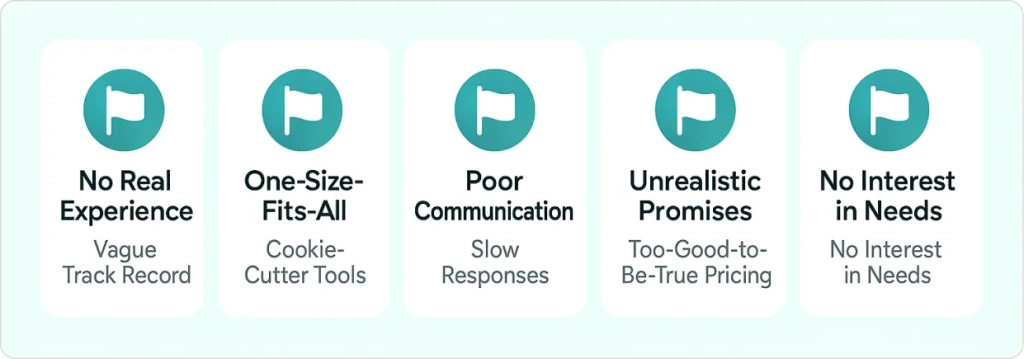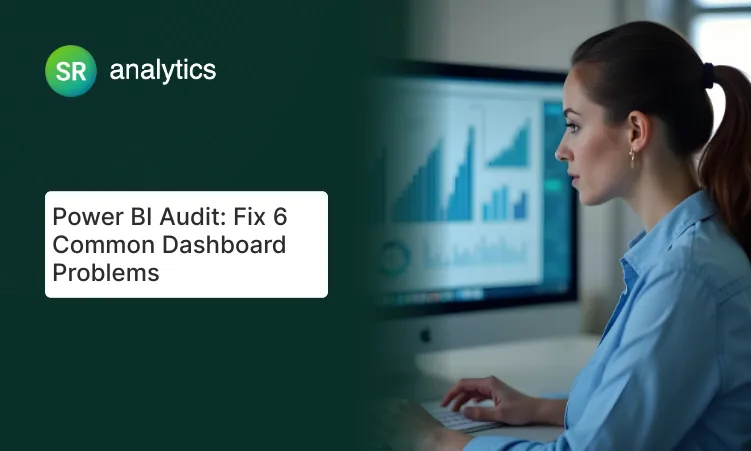Highlights:
- 70-80% of BI projects fail worldwide due to wrong partner choices
- Only 33% of data leaders are satisfied with their analytics usage
- BI market exploding from $29.42B in 2023 to $54.27B by 2030
- 8 essential criteria: technical expertise, industry knowledge, end-to-end capabilities
- Systematic 8-step selection process prevents costly mistakes
- 5 major red flags that signal problematic partnerships
Introduction
If you’ve ever felt overwhelmed choosing a business intelligence partner, you’re definitely not alone.
When I first started helping companies with their BI initiatives, I was shocked to learn that 70-80% of BI projects fail worldwide. Most of these failures? They come down to picking the wrong partner from the start.
Here’s the thing: 2025 is bringing some incredible opportunities with AI-driven analytics and real-time data. But it’s also creating new challenges that require genuine expertise. The reality is that only one-third (33%) of data leaders are actually satisfied with their company’s use of analytics.
In this guide, I’ll walk you through exactly how to evaluate potential BI partners so you can avoid costly mistakes and find the right fit for your organization. You’ll learn the essential criteria to look for, how to spot red flags, and what questions to ask during the selection process.
Why Getting Your BI Partner Choice Right Matters More Than Ever
Let me be honest with you: choosing a business intelligence partner isn’t just about finding someone to implement software. They become your strategic ally in data transformation.
The stakes have never been higher. The worldwide business intelligence market is exploding from $29.42 billion in 2023 to an expected $54.27 billion by 2030. This rapid growth means there are tons of new providers in the market, but here’s the catch – not all of them have the deep expertise you actually need.
The Reality of BI Project Failures
Here’s what I’ve learned from working with dozens of companies: Gartner research shows that 70-80% of BI initiatives fail due to three main reasons:
- Outdated technology choices
- Lack of skilled resources
- Insufficient business engagement
The good news? An experienced partner helps you sidestep all these common pitfalls. They bring proven methodologies, industry best practices, and technical expertise that can make or break your project.
What a Great BI Partner Actually Does
The right business intelligence partner doesn’t just implement software and walk away. They help you create a future-proof data strategy that scales with your business.
From my experience, the best partners think strategically about your long-term needs. They’re not just focused on getting your project live – they’re thinking about where you’ll be in three to five years.
The 8 Essential Criteria I Use to Evaluate BI Partners

Over the years, I’ve developed a systematic approach to evaluating potential partners. Here are the eight criteria that matter most:
1. Technical Expertise You Can Actually Verify
Start with the basics: proven experience.
When I’m evaluating a potential partner, I always look for certified Power BI consultants in whatever BI platform. Here’s why this matters: partners without certified Power BI consultants often struggle with technical complexities, leading to inefficient implementations.
What to look for:
- Concrete case studies from similar projects
- Verifiable client references
- Years in business and number of successful implementations
- Specific certifications in your chosen platform
Red flag alert: Avoid “fly-by-night” operators who can’t show substantial BI experience. Trust me, you don’t want to be someone’s learning project.
2. Industry Knowledge That Actually Applies to You
Domain expertise isn’t just nice to have – it’s essential.
I’ve seen too many projects struggle because the partner didn’t understand the client’s industry. When you work with someone who gets your sector, like retail and e-commerce, understands your KPIs and regulatory requirements right away.
Here’s what I always ask potential partners:
- Do you have clients in our industry?
- Can you show me relevant case studies?
- What industry-specific challenges have you solved?
The right partner will want to understand your specific business objectives before proposing any solutions. If they immediately start pushing tools without understanding your needs, that’s a major red flag.
3. End-to-End Service Capabilities
Look for partners who can handle the whole journey.
From my experience, the best outcomes happen when you work with a full-service partner. Why? Because BI projects involve everything from data integration to user training, and having one team handle it all saves you time, money, and headaches.
Key capabilities to evaluate:
- Data integration across multiple sources
- Custom dashboard and report development
- Data modeling and architecture
- Training and change management
- Ongoing support and optimization
Pro tip: Ask about their adjacent services like data governance and AI/ML capabilities. Today’s businesses are increasingly leveraging AI alongside their BI initiatives, so having that expertise available is valuable.
4. Communication Style and Cultural Fit
Technical skills mean nothing if you can’t work together effectively.
I cannot stress this enough: evaluate their communication style during your initial interactions. Pay attention to how they respond to questions and whether they can explain complex concepts in simple terms.
Here’s what I look for:
- Responsiveness to emails and calls
- Ability to explain technical concepts clearly
- Questions about your business (not just technical requirements)
- Collaborative approach vs. “we know best” attitude
The best partners feel like an extension of your team. Understanding end user requirements is equally essential for successful BI projects, so they need to communicate well with all stakeholders.
5. Commitment to User Adoption and Training
Here’s something I’ve learned the hard way: user adoption often determines success or failure.
Most business users aren’t data science experts, so knowing how to interpret insights can be challenging. The partners I recommend always include comprehensive training and change management in their approach.
What to evaluate:
- Training programs for different user types
- Documentation and self-service resources
- Post-implementation support offerings
- Change management expertise
Some of the best partners I’ve worked with actually help develop internal BI competency through knowledge transfer. This builds long-term organizational capability and reduces your dependency on external help.
6. Security and Compliance Expertise
Data security cannot be an afterthought.
In today’s regulatory environment, your partner needs to understand healthcare compliance requirements inside and out. I always verify their security certifications and ask about their experience with relevant compliance requirements like HIPAA or GDPR.
Key questions to ask:
- What security certifications do you have?
- How do you handle data governance in financial services?
- What’s your approach to access controls and audit trails?
- Have you worked with our specific compliance requirements?
Non-negotiable: Any casual approach to security should immediately disqualify a candidate. Professional partners understand these requirements and accommodate them without pushback.
7. Future-Proof Technology Approach
This is where I see a lot of companies make mistakes: they choose partners stuck in the past.
AI-driven analytics and real-time BI are becoming standard in modern BI tools. Your partner should be designing solutions that can accommodate future technological advances.
Here’s what forward-thinking partners know about:
- AI integration and augmented analytics
- Cloud data architectures
- Natural language processing (market expected to reach $43 billion by 2025)
- Real-time data streaming capabilities
The best partners help you build a future-proof data strategy using modern, scalable technologies rather than legacy systems.
8. Transparent Pricing and ROI Focus
Let’s talk about money – because transparency matters.
I always ask for detailed proposals that outline all costs: licenses, implementation fees, ongoing support, everything. The goal is to compare not just total cost, but the value each partner delivers.
What to evaluate:
- Clear pricing structure and ongoing costs
- ROI case studies from past projects
- Total cost of ownership considerations
- Transparency about potential additional costs
Here’s my rule: Avoid choosing solely based on the lowest bid. Investment in a data initiative should be viewed as a value center, not a cost center. Focus on partners who can demonstrate tangible business value.
My Step-by-Step Partner Selection Process

After years of helping companies choose BI partners, I’ve developed a systematic approach that works. Here’s exactly how I recommend doing it:
Step 1: Get Crystal Clear on Your Goals
Before you talk to anyone, nail down your requirements.
I always start by helping clients document their specific BI goals and success metrics. Here’s what you need to define:
- Key business objectives you’re trying to achieve
- Specific data sources you need to connect
- Number of users and their skill levels
- Security and compliance requirements
- Budget range and timeline expectations
Pro tip: Create a requirements document you can share with all potential partners. This standardizes your evaluation process and helps you compare apples to apples.
Step 2: Build Your Shortlist Strategically
Research is everything here.
I use a combination of vendor directories, referrals, and online research to create initial lists. Microsoft Partner companies offer proven technical expertise and solutions, so that’s often a good starting point for Power BI projects.
My research checklist:
- Relevant industry experience
- Strong market reputation
- Case studies and testimonials
- Industry recognition or awards
- Financial stability and business longevity
I typically recommend shortlisting 3-5 candidates who meet your essential criteria. Any more than that and the evaluation process becomes unwieldy.
Step 3: Dig Deep on Credentials and Experience
This is where you separate the real experts from the wannabes.
I always contact references from similar projects because customers are the best storytellers when it comes to a provider’s efficiency and problem-solving abilities.
Key evaluation activities:
- Request and review detailed case studies
- Contact multiple client references
- Ask for proof-of-concept demonstrations
- Evaluate their methodology and project management approach
- Assess team qualifications and certifications
Questions I always ask references:
- What went well during the project?
- What challenges did you face and how did they handle them?
- Would you work with them again?
- What would you do differently?
Step 4: Evaluate Proposals and Communication Quality
Proposal quality reveals a lot about competency and attention to detail.
Strong proposals outline solution approaches, timelines, team roles, and clear deliverables. Poor proposals often indicate limited understanding or rushed preparation.
What I look for in proposals:
- Evidence they understood your specific needs
- Clear solution approach and methodology
- Realistic timelines and resource allocation
- Transparent pricing and assumptions
- Risk mitigation strategies
Pay attention to their responsiveness throughout this process. Partners who communicate poorly during sales will likely struggle during implementation.
Step 5: Score and Compare Objectively
Create a scorecard to avoid decision paralysis.
I always recommend creating evaluation scorecards based on your most important criteria. Rate each partner consistently across technical fit, cultural alignment, support offerings, and cost considerations.
My scoring approach:
- Weight criteria based on your specific priorities
- Use a 1-10 scale for consistency
- Document reasoning for each score
- Include input from multiple stakeholders
This structured approach reduces bias and helps you make better decisions, especially when multiple partners seem qualified.
Step 6: Check References Thoroughly
Reference validation provides real-world insights you can’t get anywhere else.
Contact multiple references and ask specific questions about project delivery, communication, and ongoing support. I also recommend doing online research for additional reviews and potential red flags.
Questions that reveal the most:
- How did they handle unexpected challenges?
- What was their communication style like?
- Did they deliver on time and budget?
- How’s the ongoing relationship?
Look for patterns in feedback across multiple sources and projects. Recent references are most valuable for understanding current capabilities.
Step 7: Consider a Pilot Project
When in doubt, start small.
If you’re still uncertain about a partner’s capabilities, consider starting with a smaller engagement. Not all partners offer this, but it’s worth exploring for high-stakes projects.
Benefits of pilot projects:
- Test working relationships with limited risk
- Evaluate methodology and delivery quality
- Assess team dynamics and cultural fit
- Build confidence before larger commitments
Document lessons learned from pilots to improve larger engagements. Successful pilots often lead to expanded partnerships and long-term relationships.
Step 8: Finalize with Clear Expectations
Set yourself up for success from day one.
Ensure your contract details scope, timelines, deliverables, and support terms comprehensively. Include performance metrics and change management procedures for scope adjustments.
Key contract elements:
- Clear scope and deliverables
- Realistic timelines and milestones
- Performance metrics and success criteria
- Communication frameworks
- Change management procedures
Plan initial project phases carefully with clear review points. Strong project governance prevents small problems from becoming major obstacles.
5 Red Flags That Should Make You Run

After seeing too many failed partnerships, I’ve learned to spot the warning signs early. Here are the red flags that should immediately raise concerns:
1. They Can’t Show You Real Experience
Vague track records are massive red flags.
Many “fly-by-night” companies pop up around big trends, and you definitely don’t want to be their guinea pig. If a partner can’t provide detailed case studies or verifiable references, walk away.
Warning signs:
- Vague descriptions of “many successful implementations”
- Inability to provide specific client examples
- No verifiable references from similar projects
- Reluctance to share case studies or testimonials
Professional partners readily share success stories and client testimonials. If they’re evasive about their experience, there’s probably a good reason.
2. One-Size-Fits-All Approach
Cookie-cutter solutions rarely work for unique business needs.
Be wary if partners immediately push specific tools without understanding your requirements. Strong partners ask detailed questions about your business, data, and objectives before proposing anything.
Red flag behaviors:
- Immediate product recommendations without analysis
- Saying “you just need our product” without understanding needs
- Limited questions about your business context
- Only one solution regardless of the problem
Effective BI requires tailored approaches that fit your organizational culture and requirements. Generic solutions often fail to deliver expected business value.
3. Poor Communication From the Start
Communication problems during sales predict worse issues during implementation.
Slow responses, lack of clarity, or difficulty scheduling meetings signal future communication issues. Partners should be most attentive before winning your business.
Communication red flags:
- Slow responses to emails and calls
- Inability to explain concepts clearly
- Difficulty scheduling meetings or calls
- Lack of follow-through on commitments
Good communication sets the foundation for successful partnerships. If they’re hard to reach now, imagine how frustrating the project will be.
4. Unrealistic Promises or Suspiciously Low Prices
If it sounds too good to be true, it probably is.
Caution if partners promise “instant BI success” or provide drastically lower quotes than others. Experienced partners understand BI project complexity and set realistic expectations.
Warning signs:
- Promises of instant or guaranteed results
- Quotes significantly lower than market rates
- No discussion of potential challenges
- Overly optimistic timelines
Extremely low bids often hide scope omissions or quality issues. Sometimes low bidders plan to increase costs through change orders later.
5. They Don’t Ask Questions
Disengaged partners who don’t ask detailed questions lack proper consultation skills.
If partners don’t ask about your objectives, challenges, users, and data, that’s a bad sign. Good partners should be as inquisitive as they are knowledgeable.
Question red flags:
- No questions about business objectives
- Little interest in understanding your challenges
- Assumptions about your requirements
- Lack of curiosity about your current state
Partners should want to understand your business context, technical environment, and success criteria. This information is essential for proposing appropriate solutions and accurate timelines.
What I Tell Every Client About Making the Final Decision
Choosing the right business intelligence partner is one of the most important decisions you’ll make for your data strategy. From my experience, the right partner doesn’t just implement software – they become a strategic ally who helps create a future-proof data strategy.
The Bottom Line
Here’s what I’ve learned after years of helping companies with their BI initiatives: the partners who deliver the best results are the ones who truly understand your business, communicate effectively, and think strategically about your long-term needs.
With the right BI partner by your side, you’ll gain insights faster, make decisions with confidence, and stay ahead of the competition in 2025 and beyond.
What I Tell Every Client About Making the Final Decision
Choosing the right business intelligence partner is one of the most important decisions you’ll make for your data strategy. From my experience, the right partner doesn’t just implement software – they become a strategic ally who helps create a future-proof data strategy.
Here’s what I’ve learned after years of helping companies with their BI initiatives: the partners who deliver the best results are the ones who truly understand your business, communicate effectively, and think strategically about your long-term needs. With the right BI partner by your side, you’ll gain insights faster, make decisions with confidence, and stay ahead of the competition in 2025 and beyond.
The evaluation process outlined in this guide – from defining your requirements to checking references thoroughly – requires time and effort, but it’s an investment that pays significant dividends. Organizations that rush through partner selection often face project delays, cost overruns, and failed implementations that could have been avoided with proper due diligence.
Take the time to systematically evaluate potential partners using the eight criteria we’ve discussed. Create scorecards, contact multiple references, and don’t be afraid to ask tough questions about their experience, methodology, and approach to your specific challenges. The right partner will welcome this scrutiny and provide transparent, detailed responses.
If you’re ready to transform your data strategy with expert guidance, our comprehensive business intelligence consulting services can help accelerate your BI journey and ensure successful implementation from strategy through adoption.














